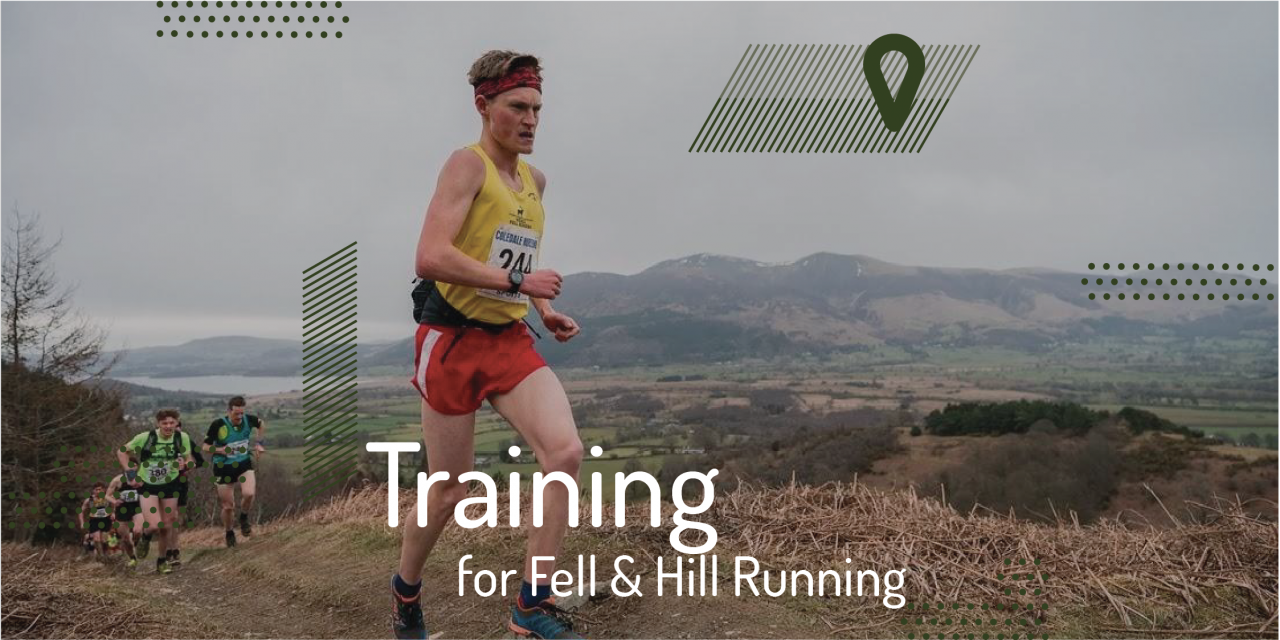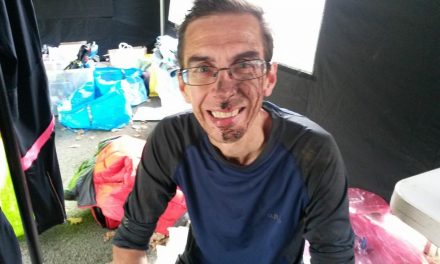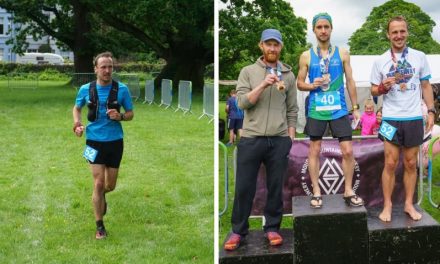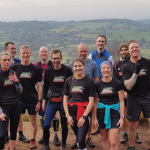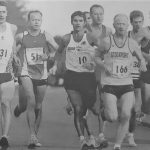Fell running, also sometimes known as hill running is the sport of running and racing, off road, over upland country where the gradient climbed is a significant component of the difficulty. The name arises from the origins of the English sport on the fells of northern Britain, especially those in the Lake District.
https://fellrunner.org.uk (England), http://www.nimra.org.uk (Northern Ireland), http://www.scottishhillrunners.uk (Scotland), http://www.wfra.me.uk (Wales).
Training requirements: Winter base-training, pre-season preparation, in-season maintenance, specific event conditioning and technique including up-hill (including hiking) and downhill running skills, navigation skills, supplementary exercises: weights, body weight, core stability, balance and coordination, cross training: walking, hiking, cycling etc.
Training plan summary for fell and hill running in the UK:
September-December (12-14 weeks)
Base training block 1:
(General improvements in cardio-vascular fitness)
KEY COMPONENTS:
Progressive increase in training volume depending on age and experience
Mostly aerobic steady running (At least 80% of total volume)
Sustained runs (if not racing), and long rep sessions
Cross Country league races without taper (as fitness tests)
Weekend hilly long runs when weather allows
Participation in Fell Relays Championship late October (including taper week)
End of December (1-2 weeks)
Rest and recovery running
(Transition between training blocks)
KEY COMPONENTS:
50% reduction in training volume compared to pre-Christmas max
Possible seasonal fell race/s
January-February (6-8 weeks)
Base training block 2:
(Further improvement in top end cardio-vascular fitness)
KEY COMPONENTS:
Peaking and tapering for cross country championship races
Reduction in length of repetition sessions and overall training volume but retaining intensity
33% reduction in training volume compared to pre-Christmas max
Avoid sustained runs and focus on racing well during this period
End of February (1 week)
Rest and recovery running
(Transition between training blocks)
KEY COMPONENTS:
50% reduction in training volume compared to pre-Christmas max
February-April (6-8 weeks)
Pre-season specific hill training block
KEY COMPONENTS:
Increase in training volume and intensity depending on age and experience
Sustained undulating runs
Specific uphill and downhill conditioning sessions
Longer hill runs (particularly if aiming for longer races)
Early season race course recces
A couple of short low-key fell or hill races
First Championship race in March *1
*1 Depends on individual racing programme how much priority is given to racing in March
April (1 week)
Rest and recovery running
(Transition between training blocks)
KEY COMPONENTS:
50% reduction in training volume compared to previous block, no sessions
March-October (20-24 weeks)
Main fell and hill racing season
KEY COMPONENTS:
Maintenance training between races including additional rest days and cross-training
Peaking and tapering for championship races
33% reduction in training volume compared to pre-season training block.
Long runs reduced in length and/or used as recces
Extra easy recovery week every 6 weeks
August-October (2 weeks) *2
Complete rest
(Transition between main racing and training seasons – Annual break)
KEY COMPONENTS:
Little or no running or other intensive exercise if possible
*2 Some may want to take their annual break at a convenient time (school holidays?) in August. Others may wait until after the fell relays in October.
October-February:
Races on hills and rough terrain will test your cardio-vascular fitness to the maximum. To be competitive will require a high volume of mostly aerobic training to improve your muscle energy systems and endurance, and the right amount of more intensive lactic threshold and Vo2 Max training on both flat and hilly terrain to improve your race pace. The winter weather and early dark nights will mean that for most working runners less time can be spent on the hills, but this is when the major part of the aerobic base that needs to last a whole summer of racing should be put in.
The ideal off-season aerobic base training for fell and hill runners in the UK is to train for and participate in the cross country running season between October and February. (See training for cross country article). Before Christmas the focus should be on progressively building a larger training volume, whilst local league cross country races are perfect as lactic threshold/Vo2 training sessions to give and test improvements in fitness. After Christmas, competitive runners will be looking to peak in the cross country championship races in January and February. And the competitor who is focusing on the longer fell races like the 3 Peaks race should also be thinking about bringing in longer Sunday runs as if they were training for a spring marathon.
To be competitive at the top end may require up to 100 miles a week (12-15 hours of running), but there are international runners who don’t go much beyond 50 miles a week, usually combined with a substantial amount of cross training, usually cycling, to fill in the aerobic gap (see below). In any case the amount of weekly running should be built up over a period of years from 15-20 miles a week as a young teenager with perhaps 10 miles a week added each year from age 16 years onwards for the serious competitor.
These should include shorter rep hill sessions (see below) or fartlek, repetition sessions as well as sustained effort (tempo) and progression runs. In my experience the best balance between benefits and risk (injury and / or over-training) is achieved from a maximum of 3 sessions or 1 session and a race in a week, not exceeding 20% of total training volume.
Assuming normal working hours it may be difficult to get up into the hills in the winter during the week so when the weather allows non cross country race weekends should be utilised to keep in touch with hillier terrain where possible. This could be for a longer time on feet Sunday run, or a hill training session on a non-racing Saturday.
A break from heavy training for a week or two over Christmas will enable you to recharge your batteries and can also include participation in a one or more short winter fell or hill races to remind you why you are training so hard over this winter period, and to catch up with fellow competitors.
February to April: This is the time to get back onto the hills and increase the volume of hill specific running for a six to eight week period towards Easter, and if targeted it may include the first Fell Championship race in March. This is possibly the most intensive training period of the year for serious fell and hill runners and brings in sustained or tempo runs for endurance, and weekly uphill and downhill conditioning sessions (see below) to reacquaint the body and mind with these critical requirements of the event. It should include some recces of the early season race routes. One or two short lower key early season races will also help to remove some rustiness and should not be avoided despite the training load. A typical week at this time might include 1 hill session, a short race, a sustained 1 hour run and a long run/recce.
These are important training runs designed to improve specific endurance before you start racing in the pre-season period. Once a week is enough. The sustained effort should be an uncomfortable but sub race effort building up from 30-40 minutes initially to 70 minutes or so. During pre-season training an undulating but not too hilly course is best to enable the effort to be maintained throughout. A beneficial alternative every couple of weeks is the progression run variant of this where you start slower and gradually increase the effort throughout the run to close to but not quite race effort. This is useful for practicing pace control for longer races.
These sessions of short but intensive 30 to 90 second repetitions with strong drive from the legs and arms will most likely also have been done regularly throughout the cross country season (See cross country training). This type of hill session develops strong leg muscles increasing your stride length and also improving your starting and finishing speed. However they are more anaerobic than is ideal for longer hill races so can be reduced in favour of longer hill repetition sessions as the fell and hill running season approaches. Once gained this extra strength will be retained relatively easily by fell and hill runners in their standard training and racing.
Most fell and hill races have long steep climbs (150m-800m). Longer races may have a number of such climbs. The key to high performance on long climbs is a combination of aerobic fitness, specifically a high lactate threshold and Vo2 max, leg muscle strength and endurance, especially the glutes, calves and feet, and most importantly of all the right pacing of effort throughout the climb. Doing this correctly should allow you to climb competitively but conserve sufficient energy to continue to run strongly for the rest of the race.
On runnable long climbs you need a rhythmic shorter stepping approach from the start, keeping the arms moving but really just for balance (minimising energy usage), and most importantly staying around 90% of your maximum HR. Breathing should be deep and even, not fast and forced. If you get out of your breathing pattern early on, your legs will start to fatigue quickly (from insufficient oxygen) and you will almost definitely lose time, maybe not on that hill, but certainly later in the race. If the climb gets really steep and your breathing starts to get out of control it usually makes sense to move towards hiking to keep moving, give some respite to your running muscles and save some energy for the rest of the race.
To train for long steep climbs you need to do sessions of repetitions at around your Vo2 Max (90-95% of Max HR) between 2 and 6 minutes long per repetition for 16-25 minutes of work with a jog down recovery. So something like 8×2 minutes progressing to 4×6 minutes as you get stronger. Try to stay in control of your breathing for the first few repetitions but don’t worry if it gets tough for the final few, the body needs that stimulus to adapt. As final specific preparation for the start of the season up-hill repetitions can be followed immediately by fast runs downhill (see below) with a longer recovery at the bottom of the climb, and of course the inclusion of some short races at this stage will replicate this.
Some sessions, and longer time on feet runs should include hiking sections on steeper parts of climbs to practice that technique. Hiking on particularly steep sections will be assisted by pushing the knee down with your hand during the push down part of the step but taking your hand off your knee when you pull it up for the next step. It will also help to rest your calf muscles if you plant your heel flatter to the ground when hiking.
More than any other factor, being able to run fast down steep off-road terrain is the most important quality of the top fell and hill runner. Technically there are some key elements to consider: Unless you are running down scree or snow don’t lean back and / or land heel first. If running down steep grass and muddy slopes try to place your foot flat enough to maximise stud contact. Short fast strides are better on slippery and technical ground allowing you to correct any uncontrolled movement of your feet more rapidly. Avoid long strides unless the slope is a shallow enough to stretch out and it is easy to place your feet without mishap. And even then avoid the breaking action of over-striding. The upper body should be relaxed and the arms should be used to balance you by extending them out to the sides if required.
The first few sessions in pre-season should be on relatively less steep hills to regain confidence with lower injury risk. Poor technique will injury you quickly so 6x1min repetitions with a slow jog uphill will be enough to start. Then work through a variety of downhill terrain gradually getting steeper and extending the reps up to 90 seconds or so.
Downhills can be even steeper and longer than the up-hills so the other consideration is overload of the quad muscles, especially in the early stages of the season. If you are going to be doing a race with long steep downhills try to get an equivalent quantity of downhill in at good pace a couple of weeks before to get a high level of specific muscle fatigue (Not just before a race). You will know if you have done enough because of the delayed onset of muscle soreness (DOMS) a couple of days later. Once recovered the adaptation will mean that your legs feel much stronger in the race itself.
March-October:
The fell and racing season is approximately six months long with championship races spread throughout and it is difficult to stay in good shape over such a long period. Once the championship season starts the overall training volume and intensity should be dropped by at least 1/3 compared to the pre-season period to avoid over-training. In fell and hill running there are a multitude of smaller, usually shorter relatively low key races that can be used instead of training sessions on many occasions, but for higher level competitors these need to be rationed carefully to allow more time to prepare for target races.
During the racing season peaking for target and / or championship races can be achieved by taking a couple of weeks out from racing to enable focus on specific aspects of the race ahead. This will most likely include a recce of the course and some targeted training sessions. The final week before the target race should include some form of further taper, especially for longer distance races. Ideally this should be a reduction in volume (including cross-training if this is used), but with the maintenance of some high intensity running in a shorter session.
Even with plenty of experience and years of strengthening fell and hill races are hard on the body, and in addition to additional complete and active rest days during the competitive season many top competitors use cycling (see below) to help both recovery and maintain aerobic fitness despite the reduction in running training volume. If racing two weekends in a row many competitors will not need much more than one medium effort session with some short easy running and cycling in between. It is also worth planning in one very easy week without sessions and racing every six weeks or so throughout the season to help you sustain your effort from beginning to end.
Depending on competition dates a couple of weeks at the end of the season should be set aside for some proper-down time with limited running to reset the body and mind. A return to training at the beginning of the cross country season will give just enough time to prepare for the final major event of the fell and hill running season; the British Athletics Fell Relay Championship, usually towards the end of October. Some competitors may leave their annual break until this race is completed but in any case a complete break from training and racing is an essential component of a high level training programme.
As previously mentioned cycling and other sports are often used by fell and mountain runners not only to recover from arduous races but also to build aerobic endurance. In particular cycling on hilly routes can build considerable leg strength and endurance which will help with long steep climbs in particular. On non-race weeks one of these can be a longer ride of 3+ hours but for recovery and in the last few days before a race shorter spins are more appropriate. Longer rides benefit from short easy runs the same or next day to get your running legs working again before attempting a fast running session too.
This is also an important factor in successful fell and hill running. Most fell and hill races in the UK have long sections away from marked paths and alternative routes can save or add considerable time and / or distance. As previously mentioned a recce run around the course a few weeks before the race can make an enormous difference. Every competitor should also know how to use a map and compass. The time to practice is on winter weekend long runs without the pressure but orienteering events throughout the year are also useful to learn to make navigation decisions in a competitive situation, as well as good physical training.
Supplementary exercises:
Although I am a firm believer that the necessary strength and coordination can be obtained from progressive increases in running on the terrain you are going to compete on, many people feel that they do benefit from additional leg strength and core stability work at home and in the gym. This is particularly true if you have a more sedentary desk based job or are older, and some compensation is needed for over-stretched glutes and hamstrings and under stretched hip extensors, and weak calves from wearing shoes with raised heels. Coordination and balance are a different matter and weakness in this regard can be greatly improved with a few simple drills and balance exercises like standing on one leg. (For more simple exercises see Simple Everyday Exercises article).
OTHER USEFUL WEBSITES AND ARTICLES:
https://fellrunner.org.uk/races.php
http://forum.fellrunner.org.uk/
https://www.brianmac.co.uk/fell/fcoach.htm
https://iancorless.org/2015/12/10/training-to-walk-for-ultra-trail-and-mountain-running/
https://www.inov-8.com/blog/rough-guide-fell-running/
https://mensrunninguk.co.uk/training/fell-champions-top-10-tips-faster-downhill-running/
https://www.merciafellrunners.org.uk/node/199
http://www.saddleworth-runners.co.uk/training/2017/2/10/fell-running-a-guide-to-training
https://www.serpentine.org.uk/pages/race_mountain.html
https://www.trailrunningmag.co.uk/news/articles/want-to-get-into-fell-running

